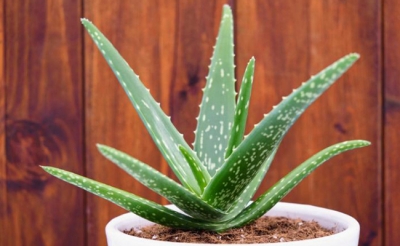
With concerns about air pollution on the rise, what can we do to purify the air we breathe in at our homes? Let’s learn about some indoor plants that can clean up the air considerably.
Air pollution is not merely an outdoor menace. The air we breathe in at home also contains high levels of pollutants. Besides biological pollutants like dust, fungi and allergens, solvents and chemicals in perfumes, hair sprays, air fresheners and furniture polish are also potential hazards. They release Volatile Organic Compounds (VOCs). Formaldehyde, carbon monoxide and nitrogen dioxides in the air lead to allergies, headache, dizziness and other health disorders. Here are some indoor plants that can clean up the air considerably.
Aloe vera
It is a succulent and perennial plant which belongs to the lily family though it looks like a cactus, with its thick fleshy leaves and thorns.
This common plant which people often hang outside their doors to ward off evil has the ability to filter benzene and formaldehyde. It requires ample sunlight but it is easy to grow and there are hundreds of varieties to choose from. Besides cleaning up the air, it has immense medicinal properties. The aloevera gel helps treat sunburn and tanning, and is good for treating pimples, too. It heals burns and several skin diseases like psoriasis, scabies, rashes and itches. Extracts from the juice are mixed with other herbs to make a drink that helps deal with gas and other stomach ailments.
Snake plant
It is so called because certain varieties have geometrically patterned scales like snakes. This indoor plant has sharp and pointed tongue-like leaves and so it is also called Mother-in-law’s tongue! It removes toxins like formaldehyde, benzene and nitrogen dioxide from the air. An ideal bedroom plant, it requires little sunlight and water and is easy to maintain. There are more than 50 species of this evergreen plant.
Bamboo palm
This slow-growing plant which originated in Central and South America helps to eliminate carbon monoxide, xylene, benzene and formaldehyde.
It needs to be kept in a shaded area which gets indirect or filtered sunlight. It does not need much water. It is enough if the soil is kept moist. It produces small yellow flowers which have a nice aroma. It is not only beneficial but can also serve as an ornate plant with its attractive upright stalks and elegant fronds.
Money plant
This long-wandering plant is an effective air purifier, removing VOCS. Native to Asia and Australia, it is so called as it symbolises wealth and prosperity in the Chinese system of Feng Shui. This creeper grows well indoors, is durable and adapts to any condition.
Rubber plant, Peace Lily and Dracena are also suitable to fight pollution.
Spider plant
It cleans up the air of benzene, carbon monoxide and xylene. This tough plant has arching grass-like leaves. It has tiny white flowers and it is so called because baby plantlets dangle from the mother plant resembling spiders on the web.
It is a no-fuss plant and adapts to any environment.
Chrysanthemum
This seasonal plant has countless varieties. It brightens up the place with its colourful flowers. Chrysanthemums remove benzene and contain a natural insecticide called pyrethrum. The flower heads are harvested and ground into a powder for use as insecticide.
Ecological balance
Different plants thrive in different seasons. For instance, while one species flowers in May, another could come into bloom as late as September. Scientists say that this time lag is crucial. This is because a huge variety of plant species are all competing for the same resources like air, sunlight and soil. The fact that plants bloom at different times ensures that each plant gets adequate resources to grow well.
However, ecologists point out that pollution is changing world climate and could disrupt this fine ecological balance in the future. For instance, increased levels of carbon dioxide could stimulate grasses and wildflowers to flower at the same time although currently they flower at different times. Tests indicate that in the presence of higher levels of carbon dioxide, grasses flower later while wildflowers flower earlier, resulting in an overlap!
This means animals that munch on grass may have to wait longer for grazing while this sudden profusion of flowering plants could well deplete natural resources, perhaps even leading to the extinction of certain plant species that aren’t tough enough to survive.
Picture Credit : Google




